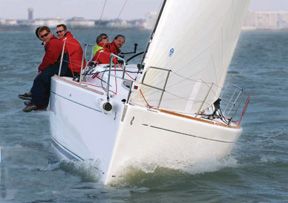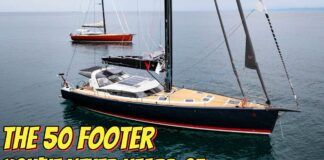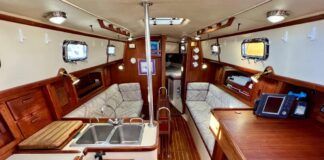Beneteau has been building boats for 122 years. Thats an impressive tradition, but does it have anything to do with an up-to-the-instant raceboat? To find out, we looked at the firms new First 10 R, a 33-foot Farr boat aimed squarely at the serious club racer. Its carbon-fiber spar, 63-inch wheel, and T-keel set it apart from traditional racer/cruisers, but its ample volume and clever accommodations make it a boat you can sleep aboard. And, like the Beneteaus of previous generations, it is built to be affordable.
Beneteau, the largest sailboat manufacturer in the world, has survived and grown by helping to popularize Euro-styling and separating its fleet into Oceanis (dedicated cruisers) and nicely performing Firsts (racier than the average racer/cruiser). The French giant caters to a worldwide market with volume to match and continues to streamline its production. It has long enjoyed significant economies of scale. All of the above have made the boats popular and affordable. While Beneteau has hired many different good designers over the decades, Bruce Farr deserves recognition as the man who has also made them fast.

Beneteaus relationship with Farr dates back to the mid-1980s with the First 45.5, versions of which went on to sell more than 1,000 boats. Shortly thereafter, a Farr First 40.7 won Key West Race Week in Florida. The marriage continues to be fruitful: Four Stars, winner of the 2006 Centennial Newport-Bermuda Race, is a First 44.7 designed by Farr Yacht Design. In all, more than 40 world championships have been won by Beneteaus designed by Farr.
Considered dangerously radical when he broke onto the scene in New Zealand with a boat that weighed less than half the displacement of its nearest competitor, Sir Bruce-awarded the Order of the British Empire over 15 years ago-has, however, evolved into a practitioner of moderate modern-day design who just so happens to have the longest winners list on the planet.
The third partner in producing the 10R is Hall Spars. Eric and Ben Hall have been in business since the mid-1980s. Their company describes itself as the only producer of carbon fiber masts to have identical factories on two continents (Bristol, R.I., and Breskens, Holland). Its mandrel-wound masts are cured in autoclaves. While a number of production builders have put carbon spars on their boats, the 10R is, as far as we know, the smallest boat to have one.
Beneteau USA President Wayne Burdick explained that the price differential between a carbon and a standard aluminum spar is about the cost of a new compact car. When asked how Hall Spars can afford to sell to cost-conscious production builders, Hall sales associate Skip Mattos answered, the high volume helps, of course, but basically its a simple, clean part. The halyard box is well-engineered and precisely machined to install simply. The customer is getting weight savings, true, but elements like improved safety, controlled prebend, and ultimate durability are plusses that help the spars pay for themselves.
“Campaigned in Europe as the First 34.7, this latest Farr First performed well this summer after its introduction at last winters Paris Boat Show. Now also built in the companys Marion, S.C., plant and given a different name-to distinguish it from the First 36.7-the 10R has continued to impress with victories in Chicagos Verve Cup (PHRF Class 6) and a good showing at the PHRF North Americans off Marblehead, Mass.
THE DESIGN
The new 10R is a product of all that has come before, but it is also its own boat. Its the smallest of the current Firsts-though they have been as small as 21 feet over the years-and introduces a strut-and-bulb T-keel to the line. This amalgam of iron (faired strut) and lead (streamlined bulb) reduces wetted surface, allows more weight to be put lower, and has other benefits, too.
An open transom and a 63-inch wheel housed in a well mark the 10R as super-serious. In short, this boat is not your grandfathers racer/cruiser.
Farr boats come in many sizes and win in many venues. Still, they have a lot in common: According to Farr, The basic philosophy that I developed back in the 70s still holds true to a surprising degree even today. I want boats that are light enough to have high performance reaching and running but still powerful enough to be strong upwind, especially upwind in waves. The formula to achieve that seems to be moderate displacement by todays standards, certainly not ultralight; moderate beam-not narrow-sufficient beam to be relatively powerful in terms of form stability; and bows that are fine enough to get through waves.”
Its not a radical formula: Its a blend of balanced ideas and elements. Farr began when the raceboat universe was masthead genoas; beamy, bumpy hulls; high centers of gravity; and pinched-in ends.
Theres no doubt sailing has changed over the past 20 years, Farr says. When we started out, boat design involved something like 80 percent experience, black art, and artistic flair. The rest, maybe 20 percent, was technology. Now, the proportions are reversed.
Foils are a good example. When I first started out, NACA sections (the library of foil shapes and their lift/drag characteristics published by the National Advisory Council on Aerodynamics) were the height of science. But we found the way wings behaved in clean air didnt match how keels behaved in turbulent water. The 10Rs keel and deep, high-aspect rudder demonstrate how far weve come.
“Farr points out that his bow shapes havent varied that much. I like a slight overhang to get the knuckle out of the water, he says. What I rediscover every so often is that the key to a bow that cuts without burying is having the longitudinal center of buoyancy well aft -around 56 percent-as opposed to the norm of 53 or 54 percent. With the 10R, keel placement (another benefit of the T-keel design) has allowed that shift, one that should help it cut through waves well.
In some ways, the design is born from seemingly contradictory market demands. North America presents a predominance of lighter air when compared to the Europe. Here, PHRF racing remains dominant. There, IRC is popular. Furthermore, Beneteau sees the boat having a future as a one-design.
Those somewhat conflicting realities were where we started, said the Farr offices Jim Schmicker, who worked on the project. Our first concern was to develop a sail plan that would give the boat competitive power under these conditions and constraints. We opted for a relatively large headsail as the best solution to maximize performance and minimize rating.
Target displacement (approximately 9,715 pounds) derived from those considerations. The IRC is relatively lacking in form restriction with just two (fore and aft) measurement points. That allowed a hullform with straight waterlines for easy acceleration and a firm bilge for sail-carrying power and the capacity to gain sailing length when heeled. The shape of her sections, Schmicker says, continues that emphasis on being powerful yet easily driven. The weight of the T-keel is more concentrated than that of a traditional fin. That frees the designer a bit. You can concentrate on a hull optimized for clean water flow, sailing characteristics, and maximum interior volume rather than being constrained by flotation calculations.
“Todays raceboats look a lot alike, but the 10R has something of a look of its own. Its short counter and curved transom, plus the minimal tumblehome of its upper topsides make it appear gathered and powerful rather than long and lean. Wooden toerail pieces (optional) along its near-straight sheerline plus the lazy curve of its house create an appearance of substance, in our opinion. She looks formidable and robust.
ON DECK
The cockpit is plenty big, but the traveler and wheel effectively chop off the after three feet. No one would accuse Farr of not knowing what makes for a workable platform for racing, but people don’t shrink as the boat does. Theres room for a crew of six (skipper included) but they wont fit into the space available without practice.
High coamings are steeple-chase barriers while racing, but when youre sitting down its nice to have something to lean against. The 10R has taken the racing option with low, wide, non-skidded steps for seat backs. They seemed to us, no matter how we slouched, to cut at about sacroiliac height.
Beneteau provides running rigging that is the latest in terms of low-stretch, lightweight, thin-line. Standard Harken controls for mainsheet fine-tuning and genoa car adjustment were sited well and worked under load. You can’t set a coffee grinder on a 33-footer, but the winches islands were separated well and at a height to be worked effectively. The flexible Seoladair Boomkicker (Solid Vang Showdown, February 2006) worked well. Robust enough to support the boom, it seemed less clumsy and more stowable than the tubular monsters that normally do the job.
We felt duly empowered behind the big (Lewmar) wheel, but we soon noticed that we were also virtually isolated there. Because of the gymnastics required to get around the wheel to move forward of the steering station, the driver has limited access to even the mainsheet (we couldnt figure how to trim it without reaching between the spokes). Handling a jibsheet or halyard seemed out of the question. Certainly the setup gives the helmsman good comfort, control, and visibility, but that comes, we felt, at the sacrifice of the ease of shorthanded sail-handling that todays cruising sailors take for granted.
ACCOMMODATIONS
Racing is undeniably the first priority with this design, but the stripped-out clich that describes most modern raceboats doesn’t quite fit. President Burdick says, we definitely wanted a boat that was cruisable. Her interior is big and bright. A compact galley (port) and mandatory nav station (starboard) are where youd expect them, amidships. The galley includes a two-burner, gimballed alcohol stove and an 18-gallon icebox. The saloon offers a big, dropleaf table and settee berth/benches. Forward and aft, however, accommodations are more innovative.
Theres plenty of room-and not much else-in the forepeaks wall-to-wall head compartment. Stark and clean enough to present no snags for spinnaker sets through the forehatch, the lonely commode still struck us as semi-comical. Although the layout actually expands area in the main saloon we couldnt escape the impression that accomodations had been shoe-horned into an abbreviated envelope.
Part of the antidote is in the double-cabin berthing arrangement aft. Platform double to starboard, generous single to port, the bunks are there. Knowing each other well seems to be part of the package, no matter how you look at it.The single-shot hull molding process (see Construction details, facing page) impacts the arrangement of the bilge. Rather than a central sump, the boat has four self-contained bins beneath the (devilishly hard to lift) cabin sole. There are no limber holes and no central sump. Instead, the bilge pumps suction head is on a hose and can be moved from box to box like the head of a Wet Vac. The setup makes routine cleaning a pain, a point made clear when we pulled up floorboards after a heavy rain one night. Three of the bins were full of several inches of water. We assumed the water came from open ports, as no streaks were evident at through-deck penetrations.
PERfORMANCE
In a blustery northwester, we helped deliver the 10R from Marion, Mass., to Newport, R.I., for the 2006 Newport Boat Show. The coastal daysail gave us plenty of time to appreciate the boats finer points.
First off, it became clear that this was a boat that goes where you point it. The big wheel is linked directly to the quadrant. A little turn produces a lot of response. Acceleration is closer to what youd expect from a dinghy than a boat with bunks. We got used to jumps in speed of a knot or more whenever the windspeed increased by 10 to 20 percent.
Boats all around us were headed the same way on the same mission. Although these were conditions that would normally dole out speed on the basis of waterline length, we easily held our own with boats-dedicated cruisers for the most part-that were 6 to 10 feet longer. Our ability to milk more speed from the puffs and maintain it longer than our rivals kept us with them despite their advantage in length.
Beneteau dealer Craig Sheard, our shipmate for the sail, recounted that the boat had been first to the weather mark in all seven races in the PHRF championships, but they are still experimenting with chute size. Ours was too small to hold some of the other guys on the runs. Burdick later relayed the fact that one-design rules have been adopted to peg the chute at about 1,150-square-feet and the furling jib to a 145 percent overlap. Sheard said the boat was capable of carrying bigger sails for PHRF or offshore work.
Shooting the breeze, we were not focused on sail trim. Just aft of the beam, the breeze was pulsing between 12 and 16 true. A bit more air and-suddenly we felt the boat take over and round up into the wind. Surfing down the smallish bay waves had been fun, but we didnt consider the conditions taxing, and the boat had been responding beautifully. In an instant, however, it rounded up into the breeze despite our best efforts. From that point forward, we dumped the main in the puffs and had no further problems.
I asked designer Schmicker to explain. We certainly don’t skimp on rudder size with a boat like the 10R. Perhaps the rudder stops kept you from having enough travel in the wheel to resist the broach properly.
“It sounded plausible, until Sheard revealed that hed already taken the rudder stops off for the North Americans. Burdick offered his take. When a boat like this accelerates in a puff, the apparent wind changes faster than youre used to. This isn’t an Oldsmobile. Its a Ferrari. But he wasnt surprised. Others had complained to him that theyd lost it.
It is worth noting that the boats mainsail was oversized for the North Americans and the headstay was pegged at maximum length, allowing some mast rake and increasing weather helm. Given the minimal lateral plane of both the T-keel and the rudder, we can see how the groove, though rapid, may be narrow. At any rate the boat deserves the caveat quite sensitive to mainsail trim. A survey of other sailors supported this observation. (Another issue we heard raised was the need for creative sheeting inboard of the shrouds-barber hauling-to achieve better headsail trim.
CONCLUSIONS
For years, weve been duly impressed by Beneteaus ability to produce good boats at affordable prices. And weve been equally impressed with Farrs continuing success (which leaves only the Americas Cup as an area of frustration). It has likewise been rewarding to watch Hall Spars grow and prosper by combining in-depth sailing experience with engineering expertise. The result is just as one might expect from such a convergence of talent and energy: fast, usable, affordable, and tough. Beneteau fans already rave about the boat, but wed like to see more starts before putting both legs on the bandwagon.
Obviously, this isn’t a boat for everyone. Clearly relaxed Sunday sailing (as we learned to our chagrin) in a blustery northwester on Buzzards Bay is not her strongest suit. For passagemaking, partying, and exploring, there are clearly better buys. But to beat the other bloke to the weather mark-and still afford to feed your family-shes an excellent bet.
CONTACT
BENETEAU USA
843/629-5300
beneteauusa.com





































